PAGE 78a – October 2008 SPECIAL MID-MONTH EDITION
H O T I D E A S F O R S M A L L R A I L R O A D S
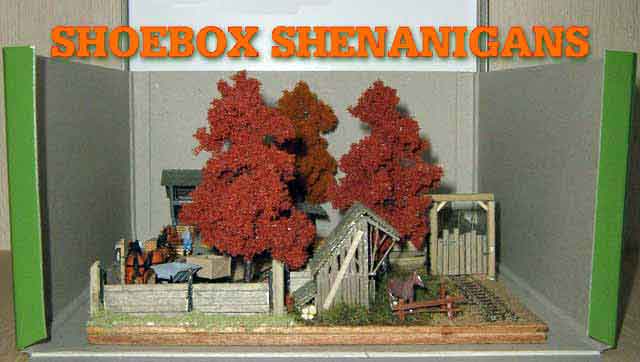
The idea of building a micro layout that will fit into a shoebox pretty much originated on this
website (see Shoebox Madness, 2002). Over the last few years it has grown into a frequent
competitive challenge at model clubs around the world… and currently online (see below).
There are two kinds: layouts that can be simply tucked into a shoebox and carried off,
and layouts that can be disassembled and their parts fit into a shoebox. Here are
some recent examples of both kinds! Also, don’t miss our newest tip about the
World’s Smallest Working Model Railroad Challenge. It’s about T Scale.
SHORTLINER JACK, IN COMPETITION, PRODUCES A BEAUTY!
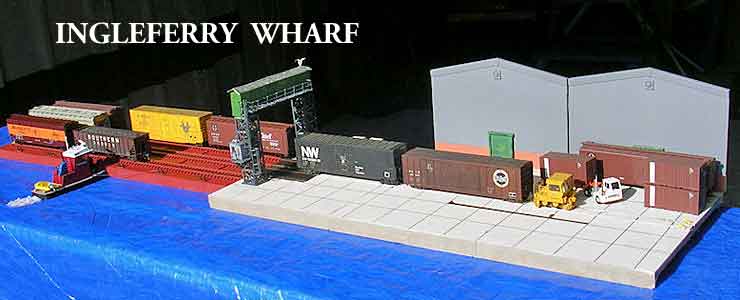
The indefatiguable Shortliner Jack Trollope, who lives in the northern Highlands of Scotland, has produced a sort of “ultimate” shoebox layout. It’s called Ingleferry Wharf, and it was developed as an entry to the Great International Shoebox Contest currently being conducted at the Railroad-Line Forums website. This Scrapbook is privileged to be permitted to give you a tour of this remarkable layout even before the contest has closed!
Jack describes the layout this way: “Basin City (usually known as Sin City) is somewhere in the United States of America and is split down the middle by the River Dax. There are rail and road-bridges joining the two halves, but most of the freight traffic is still delivered in railroad cars floated across the river on barges, pushed and pulled by small tugs called ‘towboats.’
“Ingleferry Wharf depicts one such operation. It is set in the dockside area of Sin City, and is probably not a part of town that you would want to be lost in after dark. Freight cars arrive and are repositioned on the barge for their next destination.”
The basic idea behind the layout is to put the storage tracks of a 3-2-2 Inglenook puzzle onto a car ferry that can be moved from side to side, ostensibly by a towboat. The head shunt (yard lead) is a single track located on the dockside platform. As all three tracks on the ferry are the same length, Jack has permanently fastened two boxcars at the ends of two of the tracks, thus creating the 3-2-2 capacity needed for the Inglenook game.
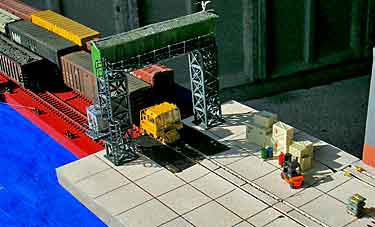
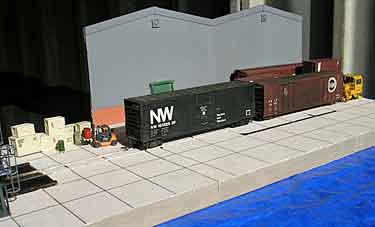
Unpacked, the layout measures 50.25×10.6in (128x27cm), a bit less than four square feet. Under the rules of the contest, the entire layout (except rolling stock and electricals) must fit into a shoebox no larger than 13x9x5in (33x23x13cm) with its lid closed. The photos below show Jack’s method of “packing ’em in.”
Here (left below) is the Chosen Shoebox, and if we open the lid (center) we can see the bottom of one-half of the barge. Removing both halves and assembling the barge (right) provides the spur tracks for the Inglenook puzzle (two cars have been fixed in place). The next layer (lower left) is the three parts of the float bridge, and under that is the three-piece dockside wharf (lower right), which assembles—like the barge—with reinforcing wood strips sliding into plastic channels beneath the structure. A variety of scenery items, including the warehouse fronts and towboat, are also contained in the shoebox.
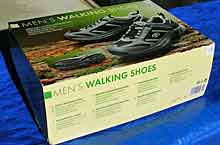
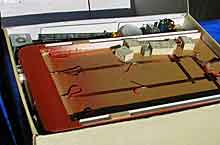
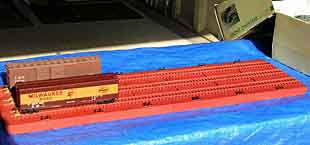
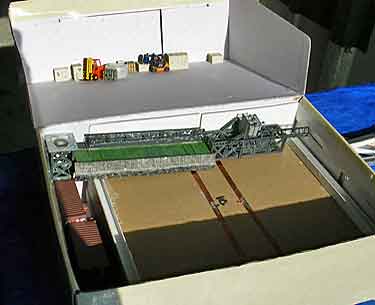
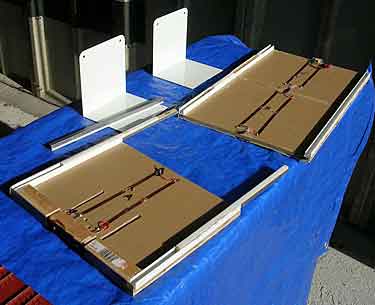
Everything is held together with small, rare-earth magnets. In particular, the barge is attached to the dockside with magnets and slides back and forth to align various tracks with the head shunt. In this case, the magnets also carry the electrical current from the feed on the dockside to the barge. These photos were all taken as Jack was preparing the layout for its first public showing at the Inverness Model Railway Exhibition on 20 September 2008.
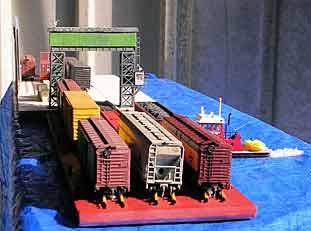
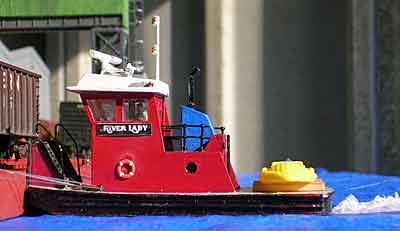
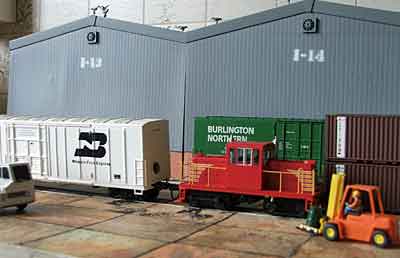
UPDATE—Since its first outing in September, this layout has received some additional scenic touches. Jack sent along a recent photo of the wharf area (left), including his brand new GE 45-ton diesel locomotive that relieves the Trackmobile for switching duty from time to time. Note the well-weathered paving and the nice decoration of the warehouse fronts, along with the addition of scenic items like containers. For more information, consult the Railroad-Line Forums’ contest entry page.
BUILDING A LAYOUT IN INDIA WITH DETERMINATION AND CREATIVITY
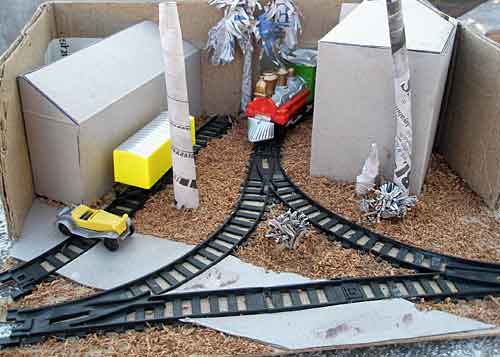
Ryan DeVries was transferred from Michigan, USA to Chennai, India for a one-year assignment. Noting that model railways were seldom encountered in India and hobby shops virtually unknown, he initially despaired of being able to follow his hobby there. Then inspiration struck in last year’s December Scrapbook #68 which showed the cardboard “glitter houses” of Howard Leroy Lamey. Ryan conjectured that a complete layout might be built with commonly available materials like paper and cardboard!
“I was happy to find a cheap little Christmas train set that was about N scale,” Ryan explains. “As the [battery-powered] train works best being pulled not pushed I needed to have a circle of track, but I wanted more than a pizza. After some playing around I came upon my favorite layout design element, the wye. On the right, the front and back off-layout connections can be joined to form a loop. Then on the left, I can line up a loose section of track with either the main or the spur [a cassette!]. In future this will connect to another shoebox to form a dogbone.”
In keeping with the toy-train look of the rolling stock, Ryan constructed some simple buildings and grass from cereal boxes. The ground cover is from the husk of a coconut, and the palms are made from newspapers. Everything is held together with paste and superglue — a triumph of modeling ingenuity!
“I am in debate over coloring it all or leaving it as is,” Ryan continues. “My seven-year-old neighbor, Madhav, wants it painted. But when I told him he would not be able to play with it for a few days after painting he said maybe not. As is he will come over and play with this train for three to four hours straight every night if we let him. I gave the layout the name Madhav Kotakam in honor of him.”
Postscript: Ryan has now returned to the U.S. When he left India, he gave the layout to Madhav. Ryan concludes, “I think the greatest aspect is that I have opened the eyes of a seven year old that he can not only have toy trains but a model railroad.”

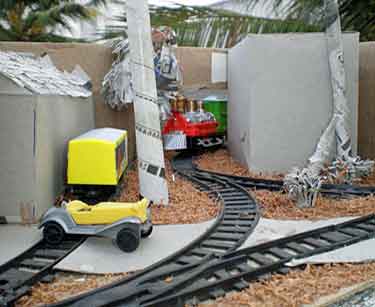
CLEVER NORWEGIAN DESIGN BEING BUILT IN ENGLISH SHOEBOX
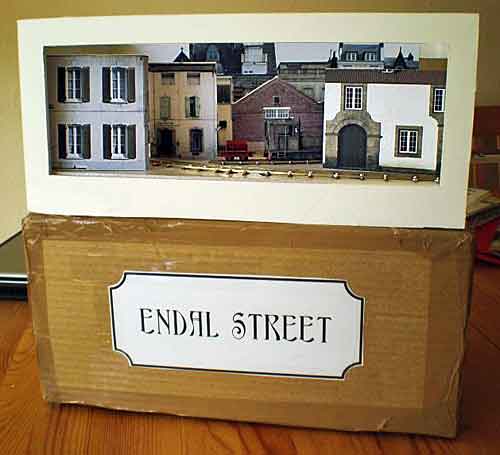
Martin Hogg, who lives in Mansfield, England, sent along some progress photos of his shoebox layout based on the Endal Street design of Jon Songøygard, from Norway. This is not a simple undertaking, as the layout is dual gauged, combining a narrow-gauge industrial line with a standard (normal) gauge trolley/tram railway—using overhead wire (catenary)!
“I figured it might be quite nice to try and build it using foamcore and card/paper,” Martin writes. “The turntable and sector plate might present some difficulties.. but I’d worry about that later. So far: box built, track built (soldered construction).” More recently, Martin used his new computer printer to make some scenic flats from scenes found on the internet. He’s still fiddling with the trackwork but now has some notion of how the layout will look. There’s slightly more information at his blog.
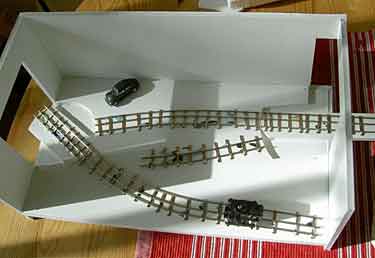
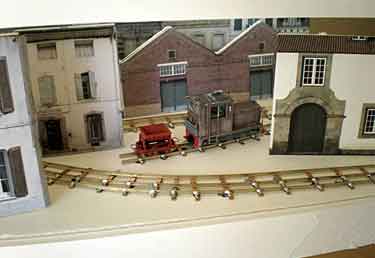
PAIR OF PIKES PROVIDE PUZZLES PLUS PLAY-VALUE
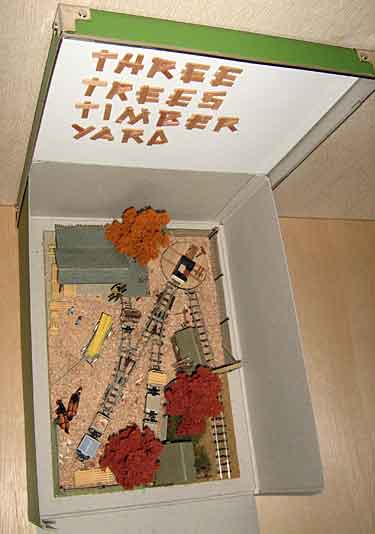
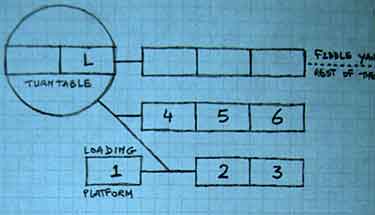
Jan Beeke, from Arnhem, Holland, built this colorful 21×29.4cm (8.3×11.6in) H0e layout for solving switching puzzles. The Three Trees Timber Yard is exactly the size of an A4 sheet of paper and fits comfortably inside a standard shoebox. Track and rolling stock are by Roco.
In the configuration shown in the photos and track plan (above), the train crew’s job is first to move a loaded car from the loading platform to the main line at the gate, ready to move out to the rest of the world (i.e., the fiddle yard). Then move an empty car from the storage track to the laoding platform, and repeat. There’s plenty of shunting there to keep a crew busy for quite some time!
TTTY is Jan’s first micro layout—but not his last (keep on reading!)
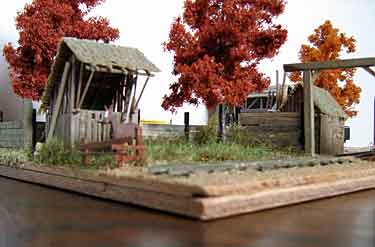
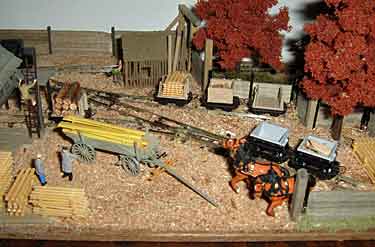
Fired up by the success of his first micro layout, Jan set to work almost immediately on his second, an On30 (0e) line measuring 36x25cm (14.2×9.8in). This one was also designed to be a switching puzzle, but this time for children. In its initial form (left, below) the line had just two car positions separated by a turntable holding a loco and one car. The loader would represent a candy mine, and the unloader would empty the car’s load of candy into the eagerly waiting child’s hands. The puzzle, obviously, is to exchange the positions of the two cars—a good, easy switching puzzle for children. To add to the fun, Jan made it impossible for the loco to enter the loading spur (the loader is too low).
To add a little more puzzlement, Jan added two more elements (below, right). An extra spot for placing cars (designated a “loco repair shed”) and a third car—a fuel car—make the tasks more complicated. Some additional switching chores might be to move the loco forwards into the shed, or place the fuel car backwards in the shed. Jan waggishly suggests that you might trick the kids with an instruction to place Car 2 in the shed for repairs… an impossible task!
Because Jan feels that this little layout is the most compact switching puzzle possible without hidden spurs or fiddle yards—and because it’s designed for use by the younger generation—he decided to call it SmallWorld.
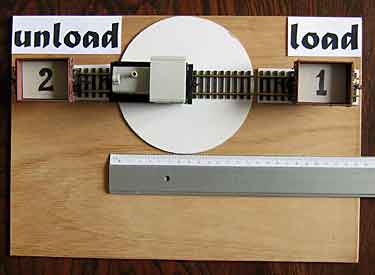
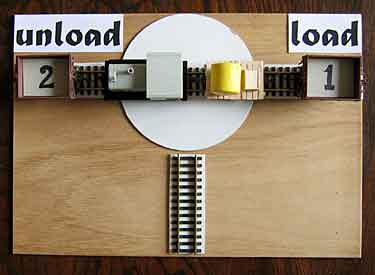
Scenic photos by Len de Vries
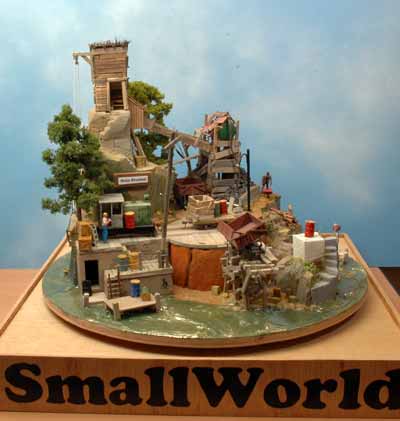
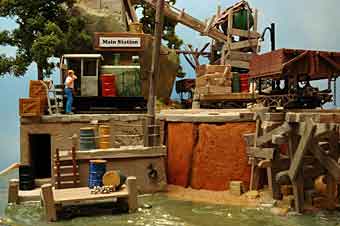
Then Jan set out to build scenery for his children’s puzzle layout. And look what happened! Suddenly SmallWorld has become an island world! And mounted on a 46cm (18in) diameter circular base, it’s outgrown its shoebox. But what a pleasure to look at! (Notice that the “loco shed” has become the “Main Station” while the candy mine loader and unloading tipple remain in position.) Jan has built a lot of kid-pleasing scenic widgets, while maintaining a good basic switching puzzle to engage the mind. Nice!
Z SCALE ISLAND FITS NICELY INTO A SHOEBOX
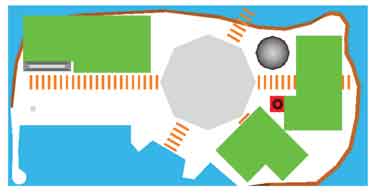
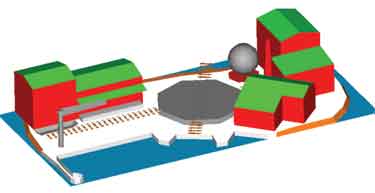
Carsten Weye Jensen, from Holstebro, Denmark, has provided another of his ingenious Z scale layouts. This one is called Musket Island, and it fits comfortably in a canonical shoebox (13x9x5in or 33x23x13cm). The island features a harbor, brewery, and loco-workshop facility. Cars enter the island from a car ferry and are shunted by one (or even two) locos to varous designated spots. The 8cm turntable will hold a loco and one car. This little layout, like the puzzle layout above, provides many opportunities for interesting shunting challenges.
MODEL A BUSY CORNER, PACK IT IN A SHOEBOX
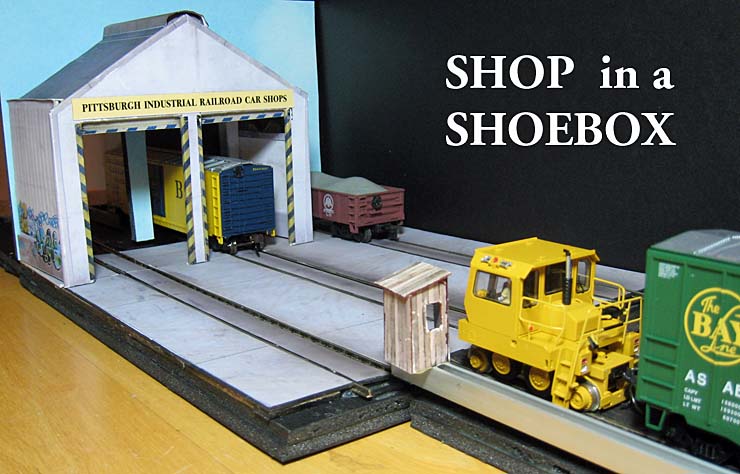
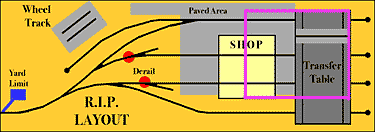
Carl Arendt, who lives in Pittsburgh, USA, made his shoebox model of the mythical Carnegie Car Repair Shops on the late Pittsburgh Industrial Railroad. This tiny layout was described in Scrapbook #73. In brief, it models three through tracks of the RIP facility diagrammed at the right (area modeled is outlined in mauve). A Peco Loco Lift stands in for the traverser and makes all electrical connections. The fiddle yard behind the shops has a rerailer on each track to make car-handling easy.
The purpose of this update is to show (below) how the entire layout, including rolling stock, can be packed into a single shoebox. Operationally, the Carnegie Shops can be as active as you wish, using not only a Trackmobile but a variety of other short locomotives in HO scale. Because the shop tracks are assumed to connect at the hidden end, it’s not unusual to have a car enter the building on one track and emerge on another, then exit the yard via the through track at the right. Traffic can be hectic!
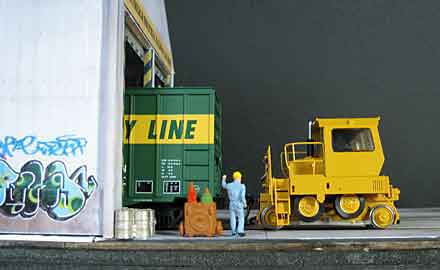
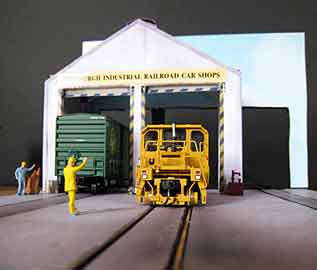
The shoebox in question (upper left, below) measures 13×9.5x5in (33x24x13cm). Opening the lid (middle) shows all the pieces and parts carefully packed away. In this view we show only the Trackmobile and one boxcar, but up to five cars and two locos will fit. The rolling stock and Loco Lift are the first parts to be unpacked (right).
Next, the shop building (a kitbashed ScaleScenes printout model) and integral sky backdrop are removed (bottom left). And finally, the through tracks (covered with a ScaleScenes concrete texture that accompanied the building) comes out along with the rerailer studded fiddle yard (bottom right). When assembled, the entire layout measures 18×8½in (46×21.6cm), plus traverser (12×2¼in or 30.5×5.7cm).
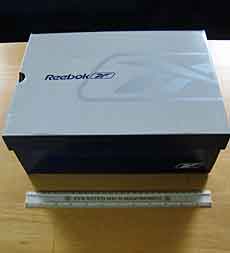
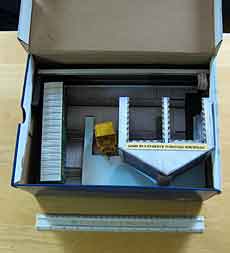
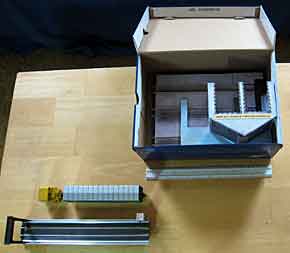
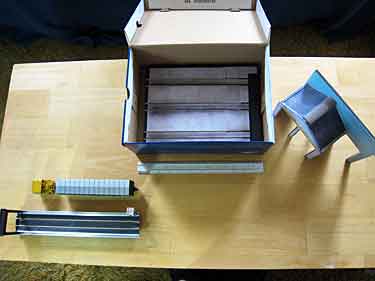
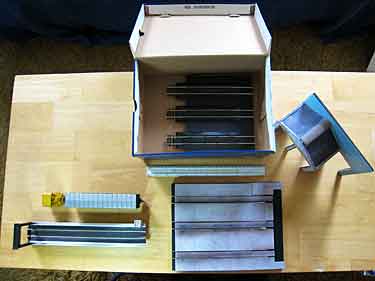
CHECK OUT THE ROTATING SECTOR PLATES!
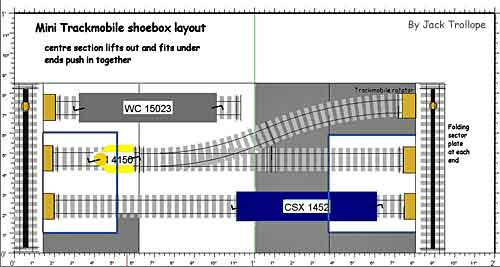
Shortliner Jack Trollope, whose shoebox car ferry layout is pictured at the top of this page, also sent a previous, unbuilt design for an ambitious Shoebox Switcher layout. This one also packs a lot of layout into a small box. Unpacked and assembled, it measures 21.5×8.5in (54.6×21.6cm) plus two cassettes.
Highlight of the layout is the rotating sector plates at either side, which pull out. turn and push into where the yellow bits are to lock in place. They can push either end into place, turning the Trackmobile (the intended motive power) in any direction, overcoming the problem of its having a coupler at only one end. Clearly, running around the cars is no problem! Ingenious, huh? Jack calls it “Choo Choo Boggs” Repair Shops [pun unfortunately intended]. He was also considering a pair of scenic fold-down repair shop facades, similar to Carnegie Car Repair Shops above, if shoebox space would permit.

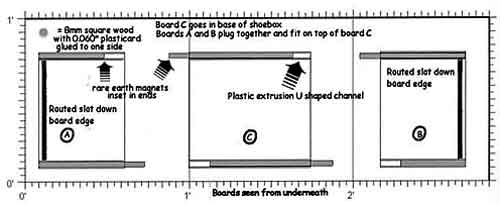
Construction of the repair shops is very similar to Jack’s car ferry layout. The baseboard is in three parts (to fit in the shoebox) held together rigidly by square rods fitting into plastic U-channels. Rare earth magnets hold everything securely together.
THIS ITALIAN LAYOUT FITS INTO A WINE BOX!

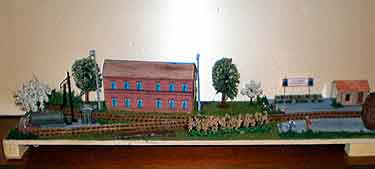
Francesco Zezza, from near Rome, Italy, set out to build the smallest possible working N-scale model layout, but with a distinctly Italian flavor. So… he built it in a wooden wine box that had served, several years ago, in a farewell celebration for a departing friend. (Not quite a shoebox, but close enough!) The layout is named La Botte (The Barrel), and it represents a small railway serving the warehouse of an Italian winery.
The layout measures 40x11cm (15.7×4.3in). Track plan is very simple: a straightforward Fork with the front spur holding a loco and the other having a two-car capacity. Operation is primarily shifting cars from the warehouse spur to the loading/unloading platforms at the right and eventually (in imagination) off to the rest of the world. Both pictured cars are FS (Italian Railway) stock, although some scratchbuilt winery cars might appear eventually.
To emphasize the Italian aura of the layout, Frencesco took an “open air” photo on a sunny day in the beautiful Italian spring, using as a background the view from his bedroom window (below).
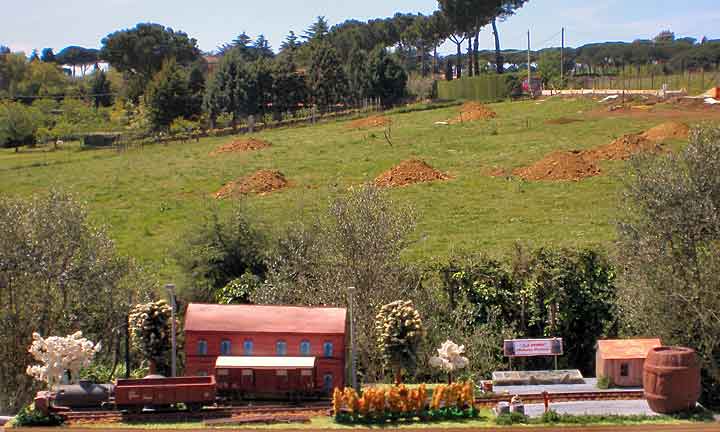
Tips for the ‘World’s Smallest’ Challenge
T Scale: Terrific or Troublesome?
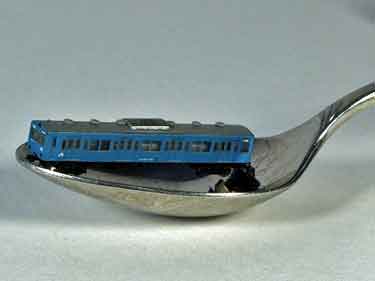
T Scale is creating something of a buzz among people looking for the world’s smallest working model railroad. It’s very small… proportions are 1:450, gauge is just 3mm, and a typical MU car is only 45mm long. The photo at the right, by Ian Holmes, from Princeton, Minnesota, illustrates the size of these little trains. This photo is used with Ian’s permission and is from his excellent blog on the subject, More T Please.
The scale was introduced in 2007 by the Japanese firm, KK Eishindo, and thus far they appear to have it pretty much to themselves. Their website shows a limited line of Japanese commuter trains, plus trackwork with two radii to make double-tracked lines. No turnouts are offered, but Eishindo also make a broad range of scenic items, including structures, vehicles, and people. Electrical control is from a battery box and is not above criticism, and no automatic couplers are on offer. At the moment Eishindo appears to be limiting their interest to the Japanese market, although several retailers in Japan are selling the trains to overseas customers.
Very few modelers outside Japan have yet obtained any T scale trains nor done any layout-building with them. There’s a forum for discussing the scale, Talking T Gauge, and several blogs including Ian Holmes’s (referenced above) and Michael Denny’s tgauge.ca. The main obstacles to layout construction seem to be the dearth of rolling stock, lack of turnouts, and general inconvenience of obtaining trains. People with experience running T scale also report that although the trains do run, they’re frustratingly fast. Other problems include unexpected stalls and couplers failing to remain together. There’s a YouTube video clip that encapsulates these experiences.
We’ve also received the following report from Yoshioka Shinichiro, who lives in Kanagawa, Japan. I’ve paraphrased some of his comments.
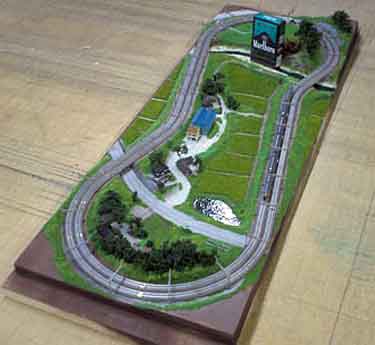
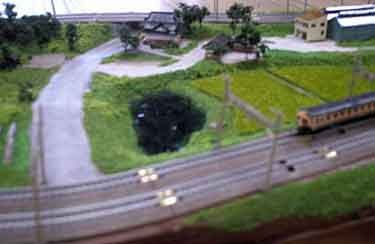
“I allotted the holiday of the first half of September to making a T-gauge layout. This train model has some difficulty in starting, and there is a fault that prevents it from smoothly performing a ‘stop and start’ at a station. Therefore, I discarded my plan to build a station and limited the arrangement of the railway track to a simple double-track loop line. It became the purpose of this layout to look at a train running through scenery.
“I had ordered the cars that ran on the Tokaido-Honsen line before the Shinkansen opened. Scenery was planned to show simply an old timer that runs through tea and rice fields. The photo (right) shows the entire line. Note the size of the cigarette box—this layout is only as large as two A3 sheets [roughly 840x297mm or 33×11.7in].
“I remodeled the stock train car (left) to make it more closely resemble the Class 80 old timer that ran on this line. The sides were redrawn with paint, and I formed a new front end using clay. The car is shown running on an embankment beside a rice field.”
Shinichiro made a YouTube video of this layout that shows pretty much the state of the art in running T scale trains (as of mid-October 2008).
From these reports and others, it seems clear that the T-scale product line has some maturing to do before it will be generally suitable for building layouts other than simple pizza loops. For this reason, I will not accept T scale entries to the World’s Smallest Working Model Railroad Challenge unless they are accompanied by proof that the equipment will actually perform as anticipated in the layout design. The best proof would most likely be a video clip of a layout mockup in action, perhaps taken with a digital camera or cell phone. —Carl Arendt
World’s Smallest Working Model Railroad Challenge: Rules and Information, Update 1
Leave a Reply